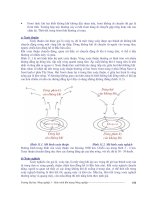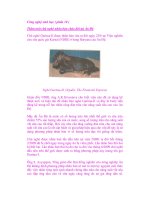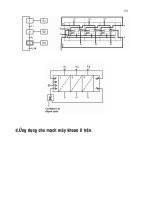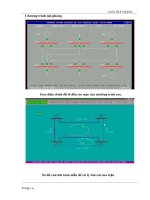Coal America’s Energy Future phần 10 pot
Bạn đang xem bản rút gọn của tài liệu. Xem và tải ngay bản đầy đủ của tài liệu tại đây (169.05 KB, 10 trang )
APPENDICES
90
91
APPENDIX 2.6
Correspondence from Industry Experts
As submitted by Clark D. Harrison, CQ, Inc.
Coal Cleaning for Control of Mercury Emissions
Because mercury is generally associated with mineral matter to a large degree, it can be partially removed by
conventional physical coal cleaning technologies. Figure 2.6.1 contains reduction data for mercury from 26
commercial or commercial-scale tests using conventional coal cleaning technologies
1
. Because they may become
important in the future, data is also provided for arsenic, chromium and selenium. The goal of the cleaning was
to reduce ash and sulfur in the clean-coal, and no special effort was made to remove trace elements in any of
these tests.
In spite of the fact that no effort was made to reduce mercury content, mercury was reduced by as much as 78%.
However, some reductions were also very low. The degree of mercury removal is dependent on several
mechanisms, including the degree of liberation of the mercury-bearing mineral, the intensity of cleaning, the
mode of occurrence of the trace element, and the method of cleaning
2,3,4
.
A
PPENDICES
92
Trace Element Reductions via
Conventional Physical Cleaning
(%)
Seam Location Arsenic Chromium Mercury Selenium
Central Appalachia 58 82 22 42
Central Appalachia 49 78 39 58
Illinois No. 6 Illinois 62 80 60 41
Pittsburgh Pennsylvania 68 47 33 9
Pittsburgh Pennsylvania 74 74 50 53
Pittsburgh Pennsylvania 75 72 30 59
Pittsburgh Pennsylvania 83 74 12 51
Pittsburgh Pennsylvania 63 79 41 37
Pittsburgh Pennsylvania 81 79 42 —
Upper Freeport Pennsylvania 40 13 — —
Lower Kittanning Pennsylvania 73 55 38 66
Sewickley Pennsylvania 51 59 26 39
Pittsburgh Pennsylvania 61 64 27 37
Pittsburgh Pennsylvania 30 27 14 12
Illinois No. 6 Illinois 20 36 12 33
Kentucky No. 9 & 11 Kentucky 46 37 24 21
Pratt & Utley Alabama 43 53 39 46
Pratt Alabama 42 58 22 57
Utley Alabama 29 23 26 33
Pratt Alabama 28 64 45 28
Upper Freeport
Pennsylvania 83 70 78 - 5
Upper Freeport
Pennsylvania
85 67 76 39
Illinois No. 2, 3 & 5 Illinois 39 51 28 33
Illinois No. 2, 3 & 5
Illinois 54 53 50 28
Kentucky No. 11 Kentucky 66 72 — 80
Kentucky No. 1
1 Kentucky 43 79 48 62
A
VERAGE 56 59 37 40
Figure 2.6.1
93
The Role of Liberation
Mineral matter occurs in coal in a variety of forms. For example, pyrite, the most studied coal-associated
mineral, can occur as anything from a massive fracture-filling form several centimeters in size to discrete
euhedral crystals a few microns in size. Comminution processes such as crushing and grinding can be used to
liberate ash- and sulfur-bearing minerals from the raw coal to allow more effective cleaning. Similarly, crushing
can also be used to increase the degree of liberation of the trace element-bearing mineral matter so that additional
quantities may be removed during coal cleaning without adversely affecting energy recovery.
Laboratory washability data can be used to measure the impact of the use of liberation during cleaning. If an
uncrushed Northern Appalachian coal is cleaned (or “washed”) using a density fractionation process, the level of
mercury reduction that can be attained while recovering 90% of the energy value of the as-mined coal is about
35%. However, by cleaning this coal after it has been crushed to minus 100 mesh, mercury reduction may be
increased to about 50% for the same level of energy recovery. If only the marginal quality, or middling, fractions
of this coal are crushed prior to cleaning, the level of mercury reduction at 90% ener
gy recovery can be about
45%. Thus, the amount of mercury reduction that may be attained during cleaning is directly affected by the
degree of liberation of the trace element-bearing mineral matter in the coal.
The Effect of Intensity of Cleaning
Typically, coal cleaning is used to remove ash-forming mineral matter from as-mined coal to reduce the cost of
transportation; lower the costs of ash collection, handling and disposal; and increase the combustion efficiency of
a boiler. Not surprisingly, increasing the intensity of cleaning to increase the reduction of ash and, in some cases,
sulfur
, also tends to yield an increase in the reduction of trace elements associated with mineral matter.
Mode of Occurrence
Mode of occurrence is the form, association and distribution of a trace element within the coal. Trace elements in
coal that are contained in lar
ge-sized minerals, such as fracture-filling pyrite, can be removed readily using
conventional physical cleaning techniques. In some cases, trace elements contained in fine-sized minerals can
also be removed by conventional cleaning. In most cases, however, crushing for liberation prior to cleaning may
be required to attain high removals of trace elements that occur in very small mineral grains. If the trace element
is bound organically, it cannot be removed by physical processes; however, chemical or biological processes may
be a removal option.
In recent years, the U.S. Geological Survey (USGS) and various coal research and industry associates have
studied the geochemical and washability characteristics of numerous coals from the major coal-producing areas
of the U.S.
2,5
. The USGS determined the modes of occurrence of many of the trace elements found in these coals
using an inventive process that involves a series of leaching steps followed by analysis of residues and leachates
6
.
Scanning electron microscopy, microprobe analysis and x-ray diffraction studies complement the leaching
studies.
In the case of mercury, a strong association with the sulfide minerals such as pyrite was noted. Therefore,
cleaning technologies that remove sulfide minerals will remove mercury
.
The Impact of the Method of Cleaning
The method of cleaning and the types of equipment used to remove ash-forming and sulfur
-bearing mineral
matter from coal can also af
fect the reduction of trace elements
2,3,4
. For example, cleaning coal using a density-
based process provides higher levels of mercury reduction at all levels of ener
gy recovery than does the use of
froth flotation.
A
PPENDICES
94
T
he primary reason for this difference in cleaning response is that pyrite is a very dense mineral that can be
removed using a density-based process. By way of comparison, fine-sized coal and pyrite sometimes have
similar surface characteristics, which make the removal of pyrite and pyrite-associated trace elements via
surface-based processes such as froth flotation difficult and inefficient. Moreover, since mode of occurrence and
textural relation evidence suggest that mercury occurs predominantly in association with the pyrite in many
coals, an interplay exists between the method of cleaning and the form, association, and distribution of the
mercury.
The selection of an effective removal method, therefore, will require knowledge of both the mode of occurrence
of a trace element and the way in which this mode will cause the element to behave during a particular cleaning
process. By coupling mineralogical information such as trace element mode of occurrence and textural
relationship with mineral processing information and knowledge, engineers can identify the most efficient and
economical coal cleaning methods to remove elements of concern from a specific coal.
Increasing Trace Element Removal During Cleaning
As stated previously, the most direct method of increasing the removal of a trace element in the cleaning process
is to clean more intensely. However, results can vary widely depending on an element’s mode of occurrence and
a host mineral’
s textural characteristics. In some cases, more intense cleaning provides a proportional removal of
a specific trace element and in other cases it does not. Also, more intense cleaning often reduces yield, increasing
the cost of cleaning on a tonnage basis.
Several options exist to reduce the loss of clean coal yield caused by more intense cleaning. In some cases,
crushing to increase the liberation of the trace-element bearing mineral may be effective; however, the benefit of
increased liberation must meet or exceed the cost of increased loading on the fines circuit and the increase in
moisture associated with cleaning finer-sized coal. In other cases, utilization of more ef
ficient cleaning
equipment or improved circuitry, possibly in combination with crushing, may be cost-ef
fective.
Figure 2.6.2 gives the results of a series of commercial-scale tests at CQ Inc. on four different Northern
Appalachian coals
2,4
. A heavy-media cyclone (HMC) circuit was used to clean the plus 0.5-mm fraction of each
coal, a two-stage water
-only cyclone/concentrating spiral circuit (WOC-Spiral) was used to clean the 0.5 mm by
150 micron size fraction, and the flotation circuit was used to upgrade the minus 150 micron size fraction.
For the first three coals, the cleaning in the WOC-Spiral circuit yielded a higher mercury reduction than did the
cleaning in the HMC or flotation circuits even though the ash reduction achieved by the
WOC-Spiral circuit was
the lowest of the three circuits in all cases. For the fourth coal, the cleaning in the WOC-Spiral circuit resulted in
the lowest mercury reduction of the three circuits. However, this result is somewhat misleading because the
intensity of cleaning (as indicated by the ash reduction) in the WOC-Spiral circuit was also the lowest of all that
were attained during testing. If the impact of the intensity of cleaning is buffered by creating a ratio of the levels
of mercury reduction to the levels of ash reduction for each test result, the results show that the use of the two-
stage, water-only cyclone/concentrating spiral circuit provided the best results in all cases.
The major mercury-bearing minerals in these coals are large-grained, fracture-filling pyrites that tend to liberate
easily
4
. In these tests, the superior performance of the WOC-Spiral circuit over that of the HMC circuit is
attributable to the liberation and subsequent removal of this mercury-bearing pyrite.
The
WOC-Spiral circuit
cleaned a smaller size fraction than did the HMC circuit, one which is more likely to contain liberated mercury-
bearing minerals. However
, in cleaning even finer-sized particles, froth flotation rejected less mercury than did
the WOC-Spiral circuit because the surface-based process removed pyrite less efficiently than did the density-
based process.
95
I
n general, increasing the amount of mercury reduction during the cleaning of coals like these can probably be
best effected by crushing the coal before cleaning and by using, in combination, a density-based cleaning process
such as a Falcon Concentrator to remove liberated pyrite and froth flotation to remove clays and other less-dense
ash-forming minerals from the finest-sized fraction of the coal.
Another option for increasing trace element removal beyond what can be achieved by physical cleaning
processes is to develop chemical processes that specifically tar
get trace elements.
While chemical cleaning
technologies have been developed that can remove ash and sulfur from coal and would likely remove trace
elements, these processes require rather extreme conditions and have not yet proved to be economical. However,
the geochemistry of trace elements is different than that of ash- and sulfur-bearing minerals and the lack of
success with the one does not prove that the other can’
t be done. For example, CQ Inc. and Howard University
have developed a process for removing large amounts of mercury from coal using mild chemical conditions, and
further work in this area is warranted
7
.
Ultimately, the success of using cleaning to reduce the trace element content of coals will depend on the
percentage of the element that is bound or
ganically
, the mode of occurrence and the textural characteristics of the
host minerals, the potential for liberation of the host minerals, the method of cleaning and the economics of
cleaning more intensely.
Mercury and Ash Reduction During the Cleaning
of Northern Appalachian Coals
Ratio of
Ash Reduction Mercury Reduction Mercury/Ash
Coal Circuit (%, Heat Unit Basis) (%, Heat Unit Basis) Reductions
1 HMC † 45.7 9.3 0.20
WOC-Spiral ‡ 20.2 24.2 1.20
Flotation 38.5 7.6 0.20
2 HMC 79.0 28.4 0.36
WOC-Spiral 33.2 62.1 1.87
Flotation 56.7 38.5 0.68
3 HMC 76.4 28.1 0.37
WOC-Spiral 25.1 51.8 2.06
Flotation 56.2 22.1 0.39
4 HMC 57.7 33.9 0.59
WOC-Spiral 17.7 18.0 1.02
Flotation 47.0 24.2 0.51
† Heavy-media cyclone
‡ W
ater-only cyclone/concentrating spiral (two-stage circuit)
Figure 2.6.2
A
PPENDICES
96
References
Akers, D.J., 1995, “The Redistribution of Trace Elements During the Beneficiation of Coal,” Chapter 6,
Environmental
Aspects of Trace Elements in Coal
, Academic Publishers, pp. 93–1
10.
Akers, D.J., 2001, “A
Method for Chemically Removing Mercury from Coal,”
The Pr
oceedings of the 26th
International T
echnical Conference on Coal Utilization & Fuel Systems
, Coal
Technology Association,
Gaithersburg, Maryland, USA, pp. 415–417.
Akers, D.J. and C.E. Raleigh Jr
., 1998, “The Mechanisms of
T
race Element Removal During Coal Cleaning,”
Coal Preparation, Vol. 19, Numbers 3–4, pp. 257–269.
Finkelman, R.B., 1993, “Air Toxics in Coal: Abundance, Distribution, Modes of Occurrence, and Textural
Relations,” Proceedings of the 10th Annual International Pittsburgh Coal Conference, the University of
Pittsbur
gh School of Engineering Center for Ener
gy Research, Pittsburgh, Pennsylvania, USA, pp. 801–805.
Palmer
, C.A., M.R. Krasnow
, R.B. Finkelman, and
W
.M. D’Angelo, 1993, “An Evaluation of Leaching to
Determine Modes of Occurrence of Selected Toxic Elements in Coal,”
Journal of Coal Quality, 12(4), pp.
135–141.
Raleigh, C.E., Jr., and D.J. Akers, 1994, “Coal Cleaning: An Effective Method of Trace Element Removal,”
Pr
oceedings of the 1
1th
Annual International Pittsbur
gh Coal Confer
ence
, the University of Pittsbur
gh School of
Engineering Center for Energy Research, Pittsburgh, Pennsylvania, USA, pp. 96–101.
Raleigh, C.E., Jr., D.J. Akers, G.S. Janik, and B. Toole-O’Neil, 1998, “Engineering Guidelines for Precombustion
Control of Air Toxics,”
Proceedings of the 15
th
Annual International Pittsburgh Coal Conference, the University
of Pittsbur
gh School of Engineering Center for Ener
gy Research, Pittsbur
gh, Pennsylvania, USA.
Changes In Combustion Characteristics With Cleaning*
(%)
Illinois Kentucky Lower Stockton Upper & Lower Upper
Seam Name No. 6 No. 11 Kittanning Robinson Lewiston Freeport Kittanning
Location Perry, Union, Cambria, Bighorn, Kanawha, Clearfield, Nicholas,
(county, state) IL KY PA MT WV PA WV
Ash Loading 16.3–6.6 48.4–5.1 21.6–3.9 9.4–5.3 48.7–14.4 9.1–3.8 11.9–3.7
(lb/MBtu)
Potential SO
2
6.82–4.50 9.80–4.80 2.43–1.04 1.64–0.67 1.50–1.20 2.46–0.94 1.84–1.62
Emmissions
(lb/MBtu)
Volatile Matter 36.4–41.9 29.9–42.0 17.2–19.9 37.4–37.8 24.2–31.9 24.8–27.9 32.3–37.2
(wt%, dry basis)
Fouling Index 0.59–0.07 0.28–0.82 0.04–0.08 2.1–4.8 0.04–0.04 0.10–0.05 0.11–0.29
Silica Percentage 66–73 73–61 85–76 58–53 91–92 74–88 88–77
Slagging Index 1.65–0.86 1.30–1.60 0.21–0.12 2,008–2,172 0.07–0.07 0.43–0.09 0.15–0.24
EPRI Report CS-3666 CS-4434 CS-4548 CS-081 CS-4433 CS-3808 CS-4866
Number
Figure 2.6.3 *First value shown is for raw coal. Second value is for clean coal.
97
APPENDIX 2.7
Acknowledgements
The members of The National Coal Council wish to acknowledge, with sincere thanks, the special assistance
received in connection with various phases of the development of this report from:
Tim Considine, Penn State University
Frank Clemente, Penn State University
Pam Martin, The National Coal Council Staff
Global Energy Decisions
The Coal Policy Committee
A
PPENDICES
98
APPENDIX 2.8
Abbreviations
AAR American Association of Railroads
ACC American Coal Council
ACI activated carbon injection
AEO Annual Energy Outlook
AEP American Electric Power
AJCAct2004 American Job Creations Act of 2004
AMT Alternative Minimum Tax
APCD air pollution control devices
ARI
Advanced Resources International
ARM Advanced Research Materials
B&W Babcock and Wilcox
BACT best available control technology
bbl barrel(s)
bbl/d barrels per day
bcf
billion cubic feet
bcf/d billion cubic feet per day
BRAC Base Realignment And Closure
Btu British thermal units
CAIR Clean Air Interstate Rule
CAMR Clean Air Mercury Rule
CAR Cooperative Automotive Research
CCP Coal Combustion Products
CCP2
CO
2
Capture project – Phase 2
CCPC
Canadian Clean Power Consortium
CCPI
Clean Coal Power Initiative
CCS CO
2
capture and storage
CERA Cambridge Energy Research Associates
CFB circulating fluidized bed
CHP combined heat and power
CNOOC Chinese crude oil and natural gas developer
(no English translation for acronym)
CNPC China National Petroleum Council
99









